Influence of Bovine Serum Albumin (BSA) on the Tribocorrosion Behaviour of a Low Carbon CoCrMo Alloy in Simulated Body Fluids
Abstract
:1. Introduction
2. Materials and Methods
3. Results
3.1. Corrosion Behaviour
Passivation Charge Density
3.2. Viscosity Measurements
3.3. Tribocorrosion Tests
3.3.1. Friction and Current Measurements
3.3.2. Wear Quantification
3.3.3. Surface Morphology
3.3.4. Surface Chemistry
4. Discussion
4.1. Effect of BSA on Wear and Friction at Passive Potentials
4.2. Effect of BSA on Wear and Friction at Cathodic Potential
4.3. Effect of BSA and Potential on Tribocorrosion of CoCrMo Alloys
5. Conclusions
- Albumin does not affect the passivation kinetics of the CoCrMo alloy.
- Albumin reduces wear and friction.
- Albumin increases the viscosity of the solution and therefore enhances hydrodynamic effects which is the main mechanism by which albumin lowers wear, in agreement with Cao’s tribocorrosion model.
- Moreover, albumin can lower the COF below a threshold of approximately 0.22, but only under specific electrochemical conditions. As a consequence, the surface shear stress decreases and this limits the extent of mechanical mixing of oxide and metal and thus reduces wear.
- No significant albumin adsorption effects or tribofilm formation were observed in the wear tracks.
Author Contributions
Funding
Acknowledgments
Conflicts of Interest
References
- Mischler, S. Sliding tribo-corrosion of passive metals: Mechanisms and modeling. In Tribo-Corrosion: Research, Testing, and Applications; Peter, B., Jean-Pierre, C., Dirk, D., Friedrich, F., Eds.; ASTM International: West Conshohocken, PA, USA, 2013. [Google Scholar]
- Mischler, S.; Munoz, A.I. Wear of CoCrMo alloys used in metal-on-metal hip joints: A tribocorrosion appraisal. Wear 2013, 297, 1081–1094. [Google Scholar] [CrossRef]
- Cao, S.; Maldonado, S.G.; Mischler, S. Tribocorrosion of pas- sive metals in the mixed lubrication regime: Theoretical model and application to metal-on-metal artificial hip joints. Wear 2015, 15, 55–63. [Google Scholar] [CrossRef]
- Wimmer, W.A.; Sprecher, C.; Hauert, R.; Tager, G.; Fischer, A. Tribochemical re- action on metal-on-metal hip joint bearings a comparison between in-vitro and in-vivo results. Wear 2003, 255, 1007–1014. [Google Scholar] [CrossRef]
- Wimmer, M.A.; Fischer, A.; Büscher, R.; Pourzal, R.; Sprecher, C.; Hauert, R.; Jacobs, J.J. Wear Mechanisms in Metal-on-Metal Bearings: The Importance of Tribochemical Reaction Layers. J. Orthop. Res. 2010, 28, 436–443. [Google Scholar] [CrossRef] [PubMed]
- Yan, Y.; Neville, A.; Dowson, D. Tribo-corrosion properties of cobalt-based medical implant alloys in simulated biological environments. Wear 2007, 263, 1105–1111. [Google Scholar] [CrossRef]
- Yan, Y.; Neville, A.; Dowson, D. Biotribocorrosion of CoCrMo orthopaedic implant materials—Assessing the formation and effect of the biofilm. Tribol. Int. 2007, 40, 1492–1499. [Google Scholar] [CrossRef]
- Munoz, A.I.; Mischler, S. Effect of the environment on wear ranking and corrosion of biomedical CoCrMo alloys. J. Mater. Sci. Mater. Med. 2011, 22, 437–450. [Google Scholar] [CrossRef]
- Mathew, M.T.; Jacobs, J.J.; Wimmer, M.A. Wear-Corrosion Synergism in a CoCrMo Hip Bearing Alloy Is Influenced by Proteins. Clin. Orthop. Relat. Res. 2012, 470, 3109–3117. [Google Scholar] [CrossRef] [Green Version]
- Wang, Z.; Yan, Y.; Su, Y.; Qiao, L. Effect of proteins on the surface microstructure evolution of a CoCrMo alloy in bio-tribocorrosion processes. Colloids Surf. B Biointerfaces 2016, 145, 176–184. [Google Scholar] [CrossRef]
- Namus, R.; Zeng, P.; Rainforth, W.M. Correlation of the wear transition in CoCrMo alloys with the formation of a nanocrystalline surface layer and a proteinaceous surface film. Wear 2017, 376–377, 223–231. [Google Scholar] [CrossRef]
- Wimmer, M.A.; Laurent, M.P.; Mathew, M.T.; Nagelli, C.; Liao, Y.; Marks, L.D.; Jacobs, J.J.; Fischer, A. The effect of contact load on CoCrMo wear and the formation and retention of tribofilms. Wear 2015, 332–333, 643–649. [Google Scholar] [CrossRef] [PubMed] [Green Version]
- Cao, S.; Mischler, S. Modeling tribocorrosion of passive metals—A review. Curr. Opin. Solid State Mater. Sci. 2018, 22, 127–141. [Google Scholar] [CrossRef]
- Stojadinovic, J. Chemical-Mechanical Polishing of Tungsten: Electrochemical and Tribocorrosion Approach. Ph.D. Thesis, École Polytechnique Fédérale de Lausanne, Lausanne, Switzerland, 2009. [Google Scholar]
- Hofmann, S.; Sanz, J.M. Thin Film and Depth Profile Analysis; Chapter 7; Springer: Berlin, Germany, 1984. [Google Scholar]
- Mischler, S.; Mathieu, H.J.; Landolt, D. Investigation of a passive film on an Iron-Chromium alloy by AES and XPS. Surf. Interface Anal. 1988, 11, 182. [Google Scholar] [CrossRef]
- Landolt, D.; Mischler, S.; Vogel, A.; Mathieu, H.J. Chloride ion effects on passive films on FeCr and FeCrMo studied by AES, XPS and SIMS. Corros. Sci. 1990, 31, 431. [Google Scholar]
- Tanuma, S.; Powell, C.J.; Penn, D.R.; Tanuma, S.; Powell, C.J.; Penn, D.R. Calculation of electron inelastic mean free paths (IMFPs) VII. Reliability of the TPP-2M IMFP predictive equation. Surf. Interface Anal. 2003, 35, 165. [Google Scholar] [CrossRef]
- Munoz, A.I.; Mischler, S. Interactive effects of albumin and phosphate ions on the corrosion of CoCrMo implant alloy. J. Electrochem. Soc. 2007, 154, C562–C570. [Google Scholar] [CrossRef]
- Milošev, I.; Strehblow, H.H. The composition of the surface passive film formed on CoCrMo alloy in simulated physiological solution. Electrochim. Acta 2003, 48, 2767–2774. [Google Scholar] [CrossRef]
- Bao, Y.; Kudo, T.; Cao, S.; Munoz, A.I.; Mischler, S. Passivation charge density of CoCrMo alloy in different aqueous solutions. J. Biol. Tribo-Corros. 2020, 6, 58. [Google Scholar] [CrossRef]
- More, N.S.; Diomidis, N.; Paul, S.N.; Roy, M.; Mischler, S. Tribocorrosion behavior of Œ≤ titanium alloys in physiological solutions containing synovial components. Mater. Sci. Eng. C 2011, 31, 400–408. [Google Scholar] [CrossRef]
- Guadalupe, S.; Cao, S.; Cantoni, M.; Chitty, W.; Falcand, C.; Mischler, S. Applicability of a recently proposed tribocorrosion model to CoCralloys with different carbides content. Wear 2017, 366–377, 203–211. [Google Scholar] [CrossRef]
- Hutchings, I.; Shipway, P. Tribology: Friction and Wear of Engineering Materials; Butterworth-Heinemann: London, UK, 2017. [Google Scholar]
- Zuon, Q.; Huang, P.; Su, F. Theory analysis of asymmetrical electric double layer effects on thin film lubrication. Tribol. Int. 2012, 49, 67–74. [Google Scholar]
- Chu, L.M.; Li, W.L.; Hsu, H.C.; Tsai, J.S. Effects of Electric Double Layer on Pure Squeeze Motion of Circular Contacts—An Elastohydrodynamic Lubrication Model. Adv. Mater. Res. 2012, 486, 497–502. [Google Scholar] [CrossRef]
- Wimmer, M.A.; Loos, J.; Nassutt, R.; Heitkemper, M.; Fischer, A. The acting wear mechanisms on metal-on-metal hip joint bearings—In vitro results. Wear 2001, 250, 129–139. [Google Scholar] [CrossRef]
- Fischer, A.; Weiss, S.; Wimmer, M.A. The tribological difference between biome- dical steels and CoCrMo-alloys. J. Mech. Behav. Biomed. Mater. 2012, 1, 50–62. [Google Scholar] [CrossRef] [PubMed] [Green Version]
- Büscher, R.; Fischer, A. The pathways of dynamic recrystallization in all-metal hip joints. Wear 2005, 259, 887–897. [Google Scholar] [CrossRef]
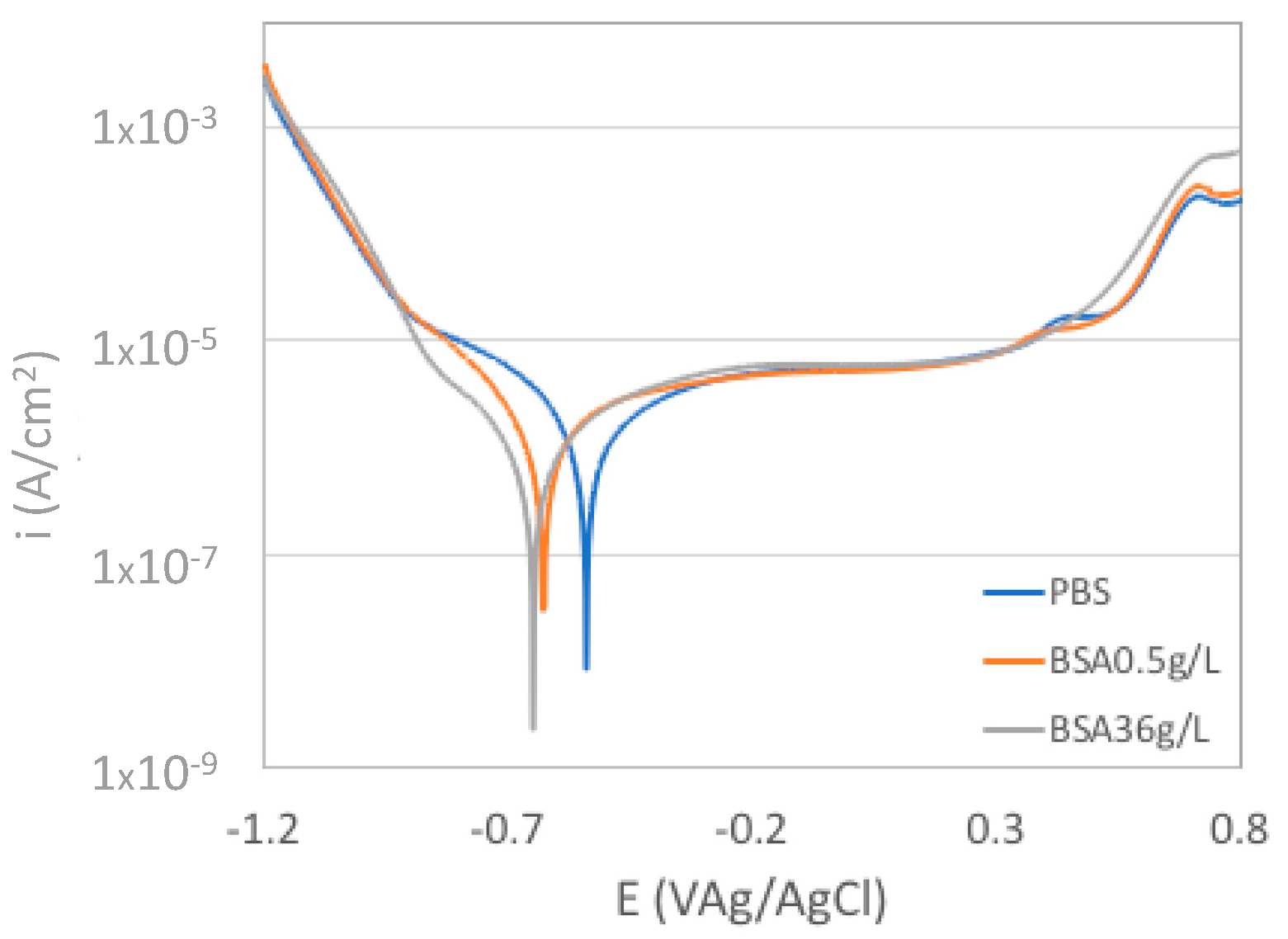



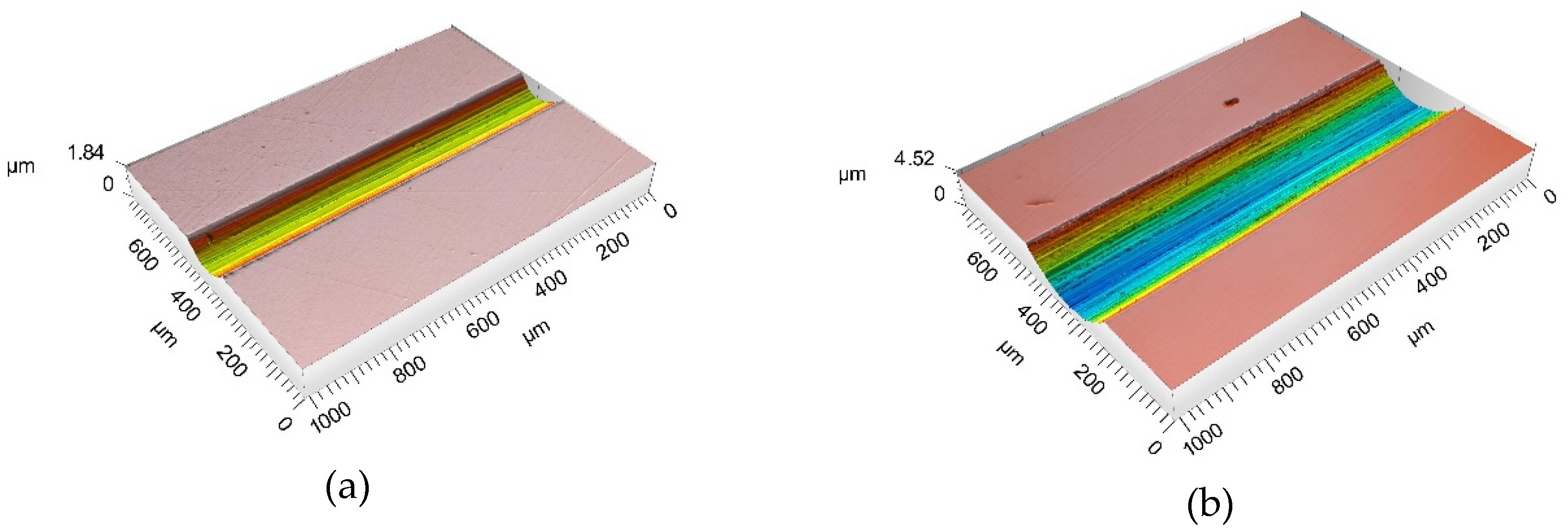
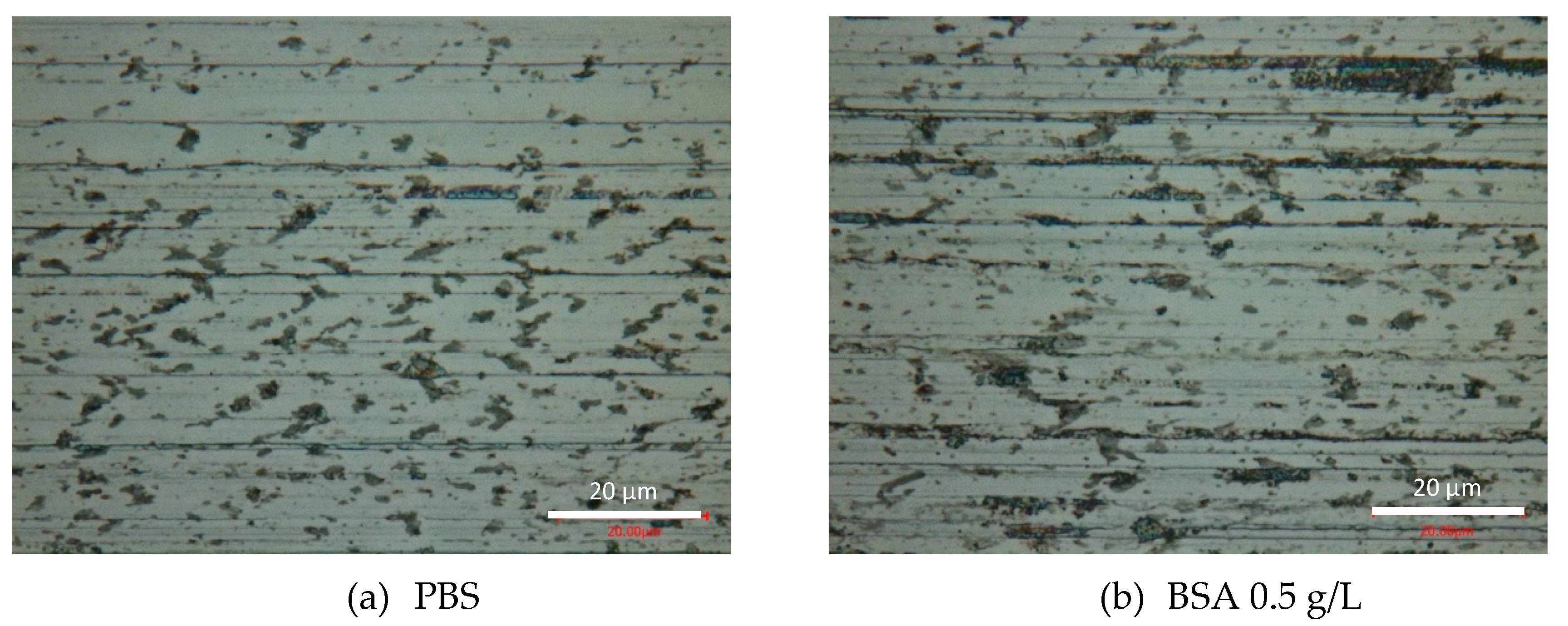
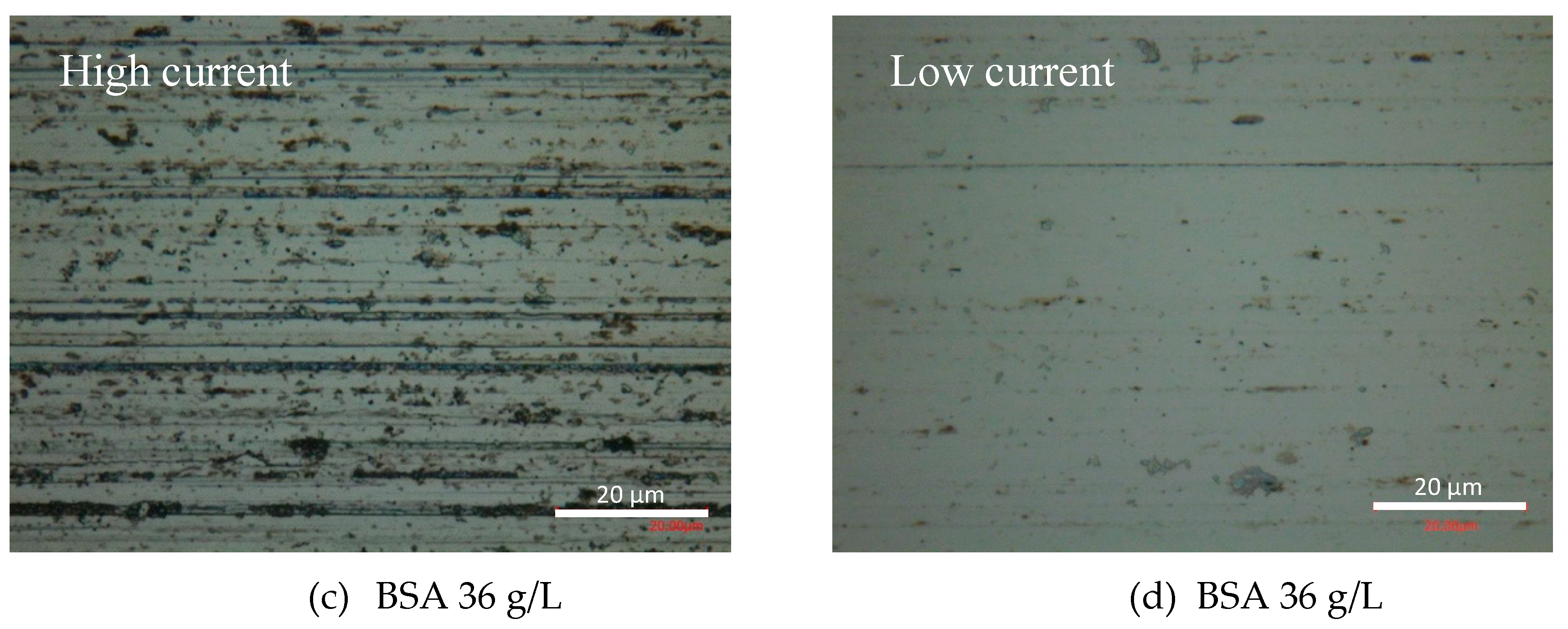


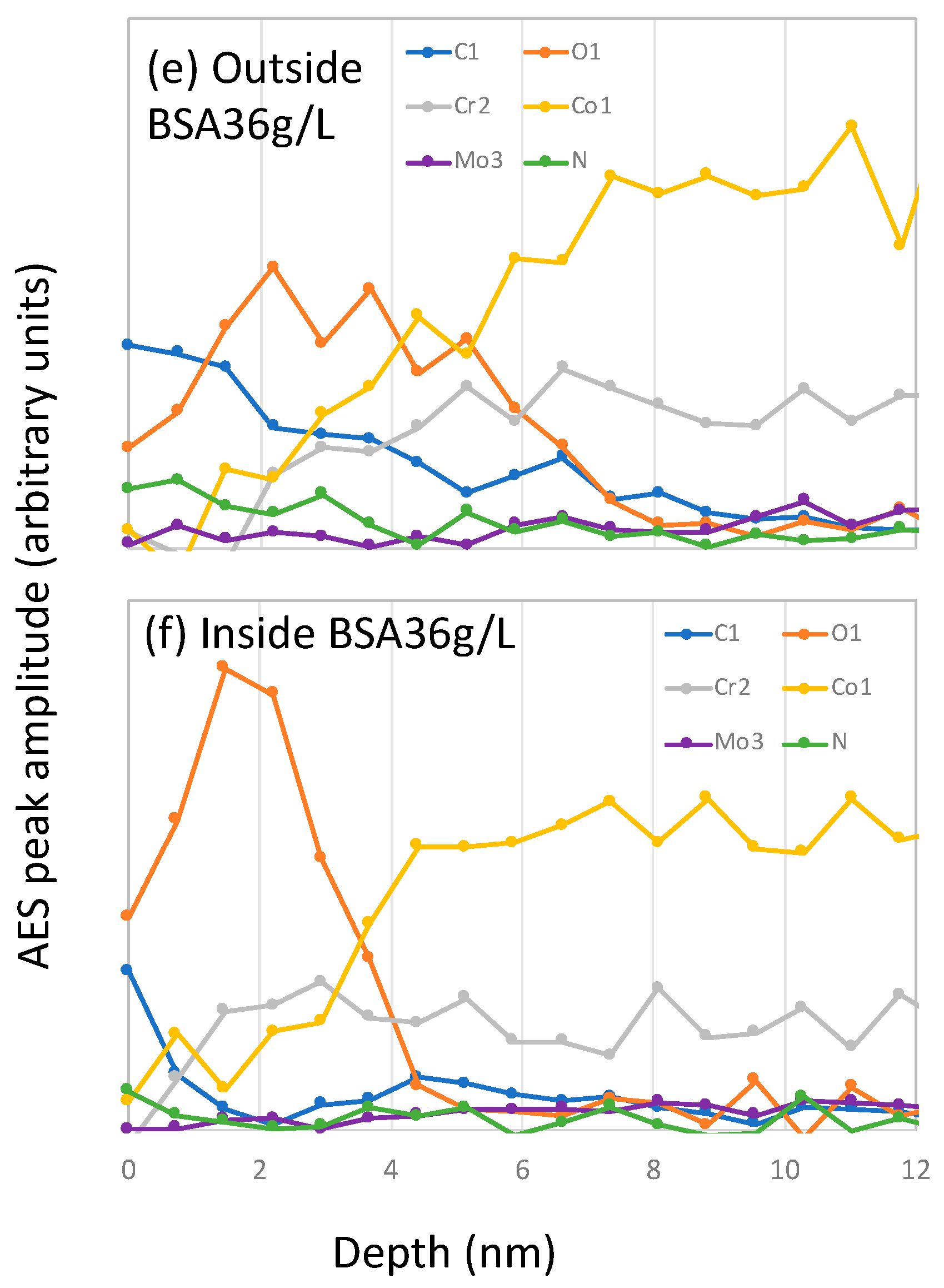



| PBS | 0.88 |
| BSA 0.5 g/L | 0.96 |
| BSA 36 g/L | 1.24 |
| Potential (VAg/AgCl) | Solution | COF | Current (Is) (mA) | Total Wear (Vtot) (10−3 mm3) | Chemical Wear (Vchem) (10−3 mm3) | Mechanical Wear (Vmech) (10−3 mm3) |
|---|---|---|---|---|---|---|
| −1 | PBS | 0.34 | −0.279 | 0.111 | 0.111 | |
| 0.35 | −0.351 | 0.0683 | 0.0683 | |||
| 0.31 | −0.371 | 0.116 | 0.116 | |||
| BSA 0.5 g/L | 0.12 | −0.425 | 0.0559 | 0.0559 | ||
| 0.13 | −0.436 | 0.0597 | 0.0597 | |||
| 0.13 | −0.349 | 0.063 | 0.063 | |||
| BSA 36 g/L | 0.18 | −0.962 | 0.140 | 0.140 | ||
| 0.19 | −0.544 | 0.141 | 0.141 | |||
| 0.17 | −0.964 | 0.107 | 0.107 | |||
| −0.2 | PBS | 0.39 | 0.297 | 2.71 | 1.60 | 1.11 |
| 0.35 | 0.0296 | 2.72 | 1.60 | 1.12 | ||
| BSA 0.5 g/L | 0.31 | 0.0280 | 2.85 | 1.51 | 1.34 | |
| 0.33 | 0.0284 | 2.92 | 1.53 | 1.39 | ||
| BSA 36 g/L | 0.20 | 0.0140 | 0.986 | 0.76 | 0.226 | |
| 0.22 | 0.0143 | 1.01 | 0.77 | 0.230 | ||
| −0.05 | PBS | 0.38 | 0.0383 | 3.66 | 2.07 | 1.59 |
| 0.37 | 0.0406 | 4.05 | 2.19 | 1.86 | ||
| 0.29 | 0.0386 | 3.69 | 2.08 | 1.61 | ||
| BSA 0.5 g/L | 0.35 | 0.0362 | 3.74 | 1.95 | 1.79 | |
| 0.35 | 0.0371 | 3.41 | 2.00 | 1.41 | ||
| 0.31 | 0.0372 | 3.94 | 2.01 | 1.93 | ||
| BSA 36 g/L | 0.27 | 0.0248 | 2.39 | 1.34 | 1.05 | |
| 0.30 | 0.0269 | 2.65 | 1.45 | 1.20 | ||
| 0.18 | 0.00374 | 0.29 | 0.20 | 0.09 | ||
| 0.20 | 0.00621 | 0.466 | 0.34 | 0.13 | ||
| 0.17 | 0.00395 | 0.285 | 0.21 | 0.07 | ||
| 0.17 | 0.00511 | 0.362 | 0.28 | 0.09 | ||
| 0.35 | PBS | 0.37 | 0.0469 | 4.05 | 2.53 | 1.52 |
| 0.35 | 0.0513 | 4.51 | 2.77 | 1.74 | ||
| 0.33 | 0.0501 | 4.53 | 2.70 | 1.83 | ||
| BSA 0.5 g/L | 0.34 | 0.0453 | 4.42 | 2.44 | 1.98 | |
| 0.3 | 0.0487 | 4.07 | 2.63 | 1.44 | ||
| 0.35 | 0.0453 | 4.27 | 2.44 | 1.83 | ||
| BSA 36 g/L | 0.25 | 0.0306 | 3.11 | 1.65 | 1.46 | |
| 0.28 | 0.0317 | 3.02 | 1.71 | 1.31 | ||
| 0.28 | 0.0301 | 2.72 | 1.62 | 1.10 |
| Electrolyte | C-Layer (nm) | |
|---|---|---|
| Inside the wear track | Outside the wear track | |
| PBS | 0.5 | 0.3 |
| BSA 0.5 g/L | 1.2 | 2 |
| BSA 36 g/L | 0.5 | 3 |
| Oxide film (nm) | ||
| Inside the wear track | Outside the wear track | |
| PBS | 2.8 | 1.5 |
| BSA 0.5 g/L | 3 | 5 |
| BSA 36 g/L | 2 | 4.5 |
© 2020 by the authors. Licensee MDPI, Basel, Switzerland. This article is an open access article distributed under the terms and conditions of the Creative Commons Attribution (CC BY) license (http://creativecommons.org/licenses/by/4.0/).
Share and Cite
Yoneyama, C.; Cao, S.; Igual Munoz, A.; Mischler, S. Influence of Bovine Serum Albumin (BSA) on the Tribocorrosion Behaviour of a Low Carbon CoCrMo Alloy in Simulated Body Fluids. Lubricants 2020, 8, 61. https://doi.org/10.3390/lubricants8050061
Yoneyama C, Cao S, Igual Munoz A, Mischler S. Influence of Bovine Serum Albumin (BSA) on the Tribocorrosion Behaviour of a Low Carbon CoCrMo Alloy in Simulated Body Fluids. Lubricants. 2020; 8(5):61. https://doi.org/10.3390/lubricants8050061
Chicago/Turabian StyleYoneyama, Choshun, Shoufan Cao, Anna Igual Munoz, and Stefano Mischler. 2020. "Influence of Bovine Serum Albumin (BSA) on the Tribocorrosion Behaviour of a Low Carbon CoCrMo Alloy in Simulated Body Fluids" Lubricants 8, no. 5: 61. https://doi.org/10.3390/lubricants8050061
APA StyleYoneyama, C., Cao, S., Igual Munoz, A., & Mischler, S. (2020). Influence of Bovine Serum Albumin (BSA) on the Tribocorrosion Behaviour of a Low Carbon CoCrMo Alloy in Simulated Body Fluids. Lubricants, 8(5), 61. https://doi.org/10.3390/lubricants8050061





